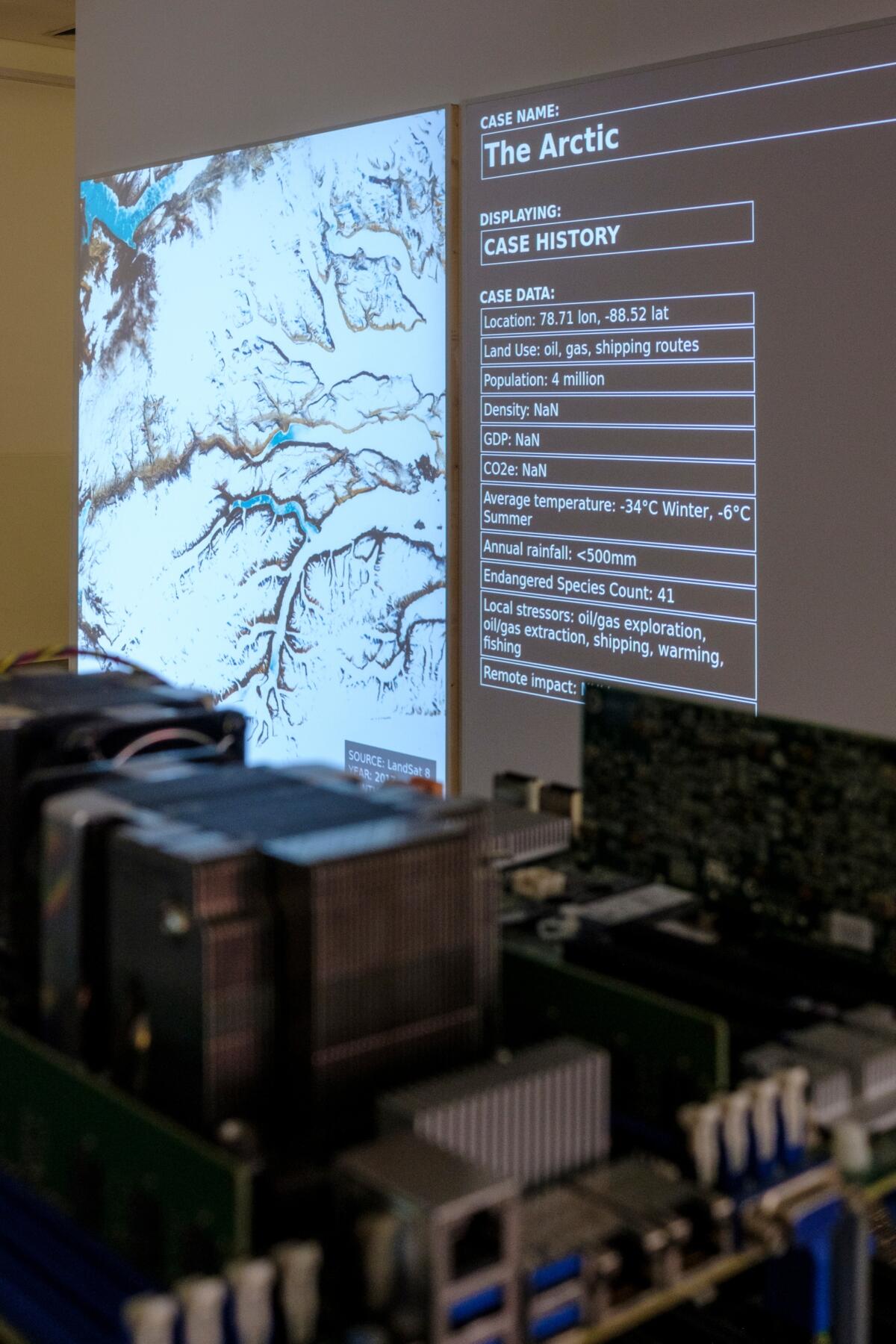
In the 1960s, when Hans Haacke first exhibited his Condensation Cubes in the museum it must have been a disconcerting experience for visitors, as the piece seemed more like a scientific experiment than a work of art. The white cube of the museum evoked the appearance of a sterile laboratory, inside was a square Plexiglas vessel with condensation dripping down its walls. The climatic conditions of the museum space, as well as the changing humidity level caused by the visitors, had a subtle but noticeable effect on the movement of the water. Haacke was interested in processes and systems, not only in nature but also in politics and cyberspace.[1] He was referring to the theories of Jack Burnham, who was among the first to discuss the interaction between scientific and technological achievements of the 21st century and the visual arts, especially sculpture. In the article “Systems Esthetics” [2], he described how the world developed from an object-oriented to a system-oriented society. A controversial statement of his was that artwork will disappear as a cultural object, being substituted with what he called “system consciousness”. [3] His attempts to develop a systems theory were a testament to the need in the 1960s to give the interface between art, science, and technology a basis for interdisciplinary work, and to draw parallels between these different fields.
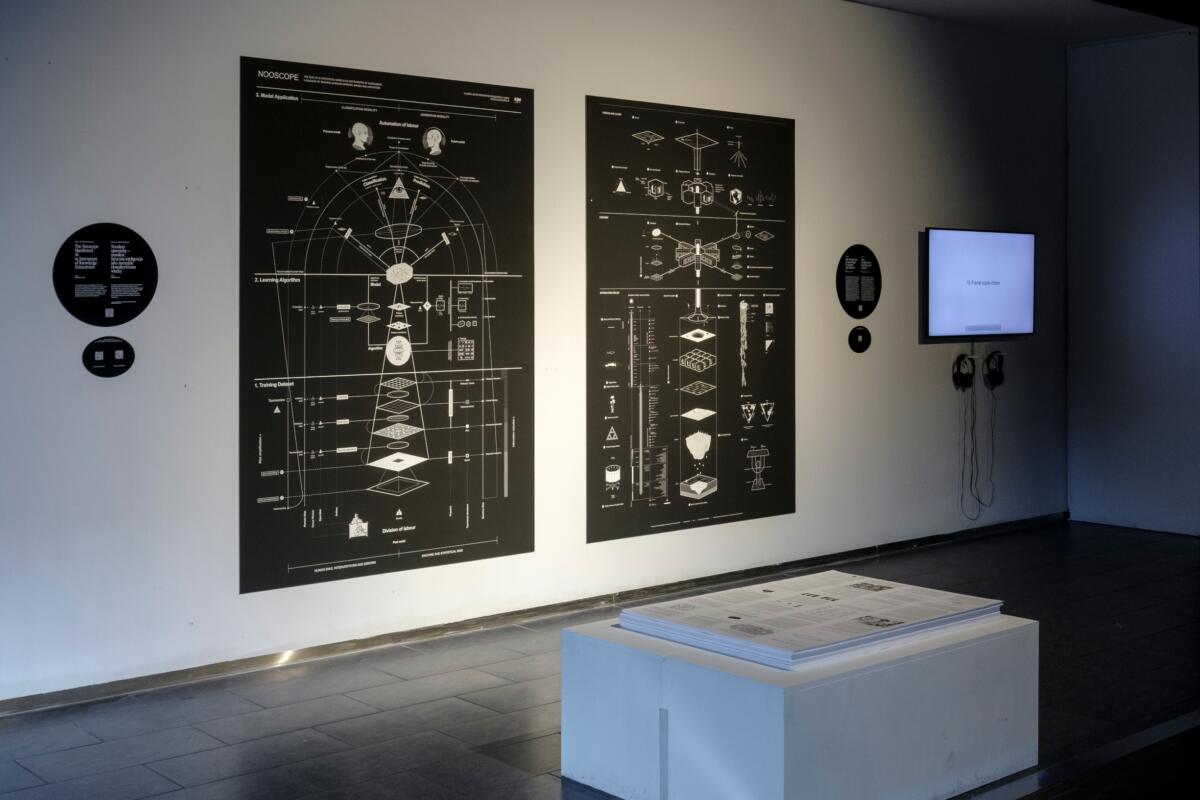
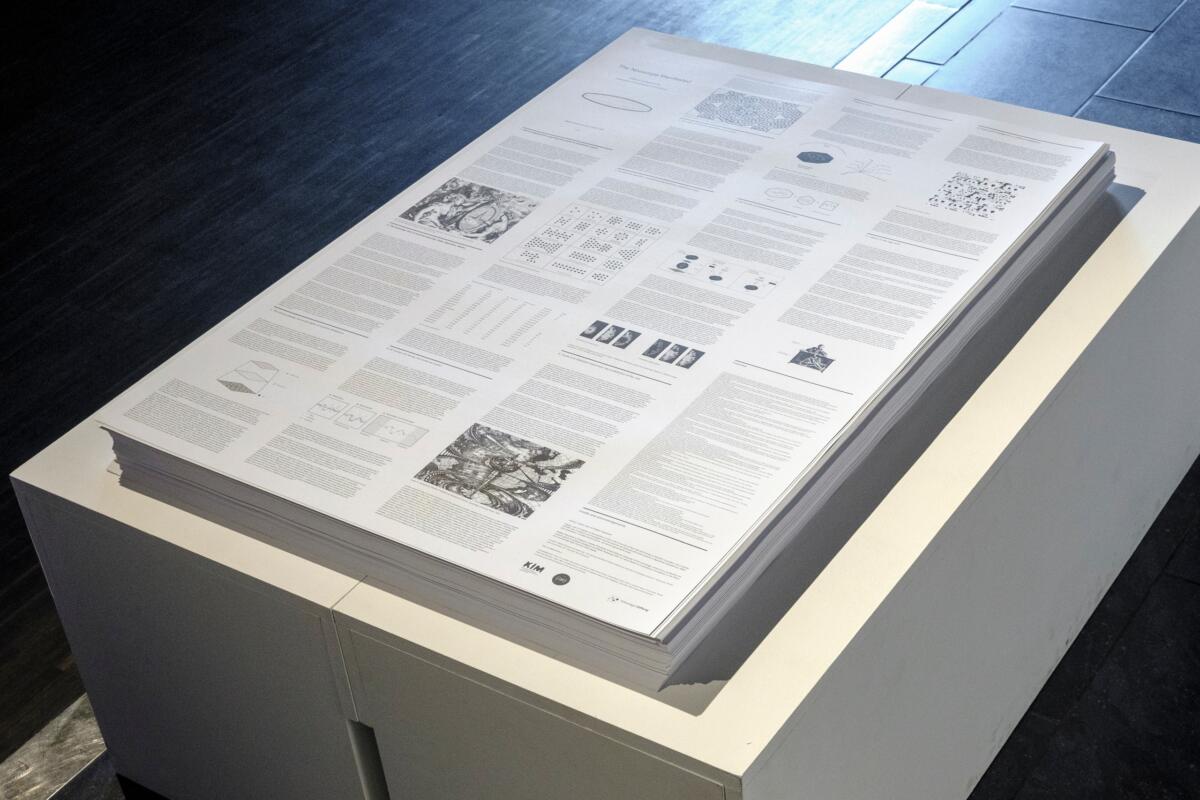
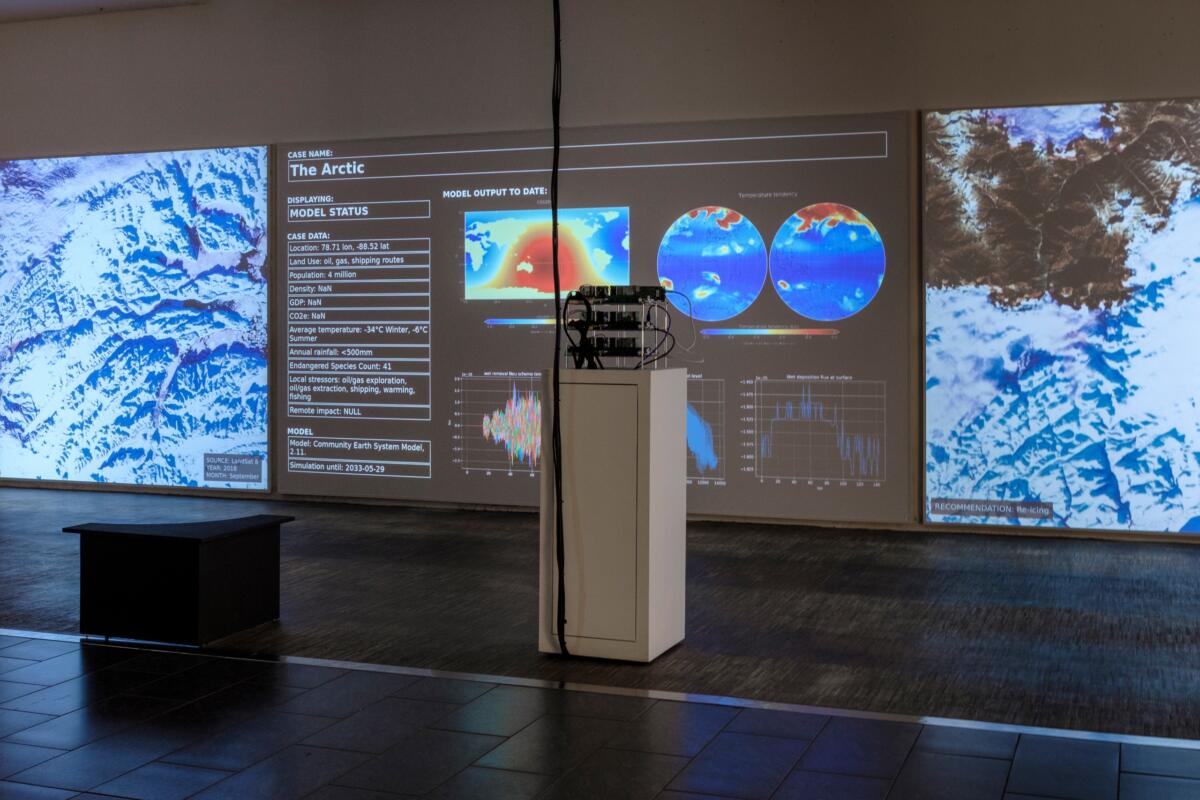
Jack Burnham’s prophecy has partly come true. As a visitor to the second edition of the Biennale Warszawa entitled Seeing Stones and Spaces Beyond the Valley, one has the feeling of having stepped into a laboratory with projected data from various scientific studies on the walls, on large sheets of paper, or framed and displayed across different tables. Statistics, numbers, and maps flash across all lines of sight. There is a threatening atmosphere in the blacked-out rooms, as if the results of these studies were predicting apocalyptic scenarios. The physical art object seemed to have vanished, giving way to scientific systems analysis. It was the difficult circumstances under which the new edition of Biennale Warszawa was created, but which also inspired its content: firstly, the effects of pandemic policy on the art scene and the temporary shift of cultural life to the online sphere, and then the war in Ukraine. In response to this, the curatorial team, Bartosz Frąckowiak, Anna Galas-Kosil, and Paweł Wodziński, promptly responded to the influx of Ukrainian refugees and reorganized their regular space into a first point of contact for refugees, offering basic necessities, accommodation, and other forms of support. Co-organized with Ocalenie Foundation and with the help of volunteers, and ordinary people living in Warsaw providing mattresses, bedding, meals and equipment, a temporary space hosted over 150 people.
Despite all of this, the exhibition concept did not actually aim to point towards a particularly gloomy future in which we will be sucked into our self-inflicted black holes through surveillance technologies, ecological crises, power struggles for raw materials or the toxic working environments of the technology industry. The first part of the title, Seeing Stones, is a reference to the palantíri communication stones from The Lord of the Rings, which allow the user to see through things, but only the dark moments. The second part of the title refers to Ramesh Sirinivansan’s book Beyond the Valley, which deals with the topic of how to use “technologies of tomorrow” [4] to make oneself independent of political and technological systems. Since 2005, Sirinivansan has been a professor at UCLA’s Department of Information Studies and Design/Media Arts, but as he explained in his talk “Borderless Digital Utopias: Embracing the Interconnections between People, Beings, Past, Present, and our Dreams”, he sees himself more as an activist. Rather than talking about speculative theory, he shared examples of how technology can be fairer and more democratic. Traveling to more than 70 countries, he studied the connection between new technologies and the social lives of the people he met, trying to find out how these links can be helpful in creating autonomous structures. For him there is only one solution to he black hole of digital manipulation and control: “To save net neutrality, we must build our own internet.”[5]
The Biennale Warszawa 2022 took place in the building of the former Wars Sawa Junior Department Store, on one of the main avenues of Warsaw, surrounded by commercial shops. Situated across from the Palace of Culture and Science, and the new Museum of Modern Art which is still under construction, it is a crossroad of commerce, politics, and culture. While there is hustle and bustle in the neighboring shops, frenzied with consumption, it was relaxing to enter the glazed, light-flooded entrance hall of the Biennale, with rows of chairs and loungers set up to accommodate the public program. Connected by an escalator, one reached the second floor, where the exhibition opened up to its visitors.
The exhibition was loosely divided into six categories, so-called thematic waves, which intentionally made it difficult to clearly allocate. Because somehow each of the works in some way addressed the six concepts: Extractivism, Algorithms, Surveillance State, Ideology, Infrastructure and Future.

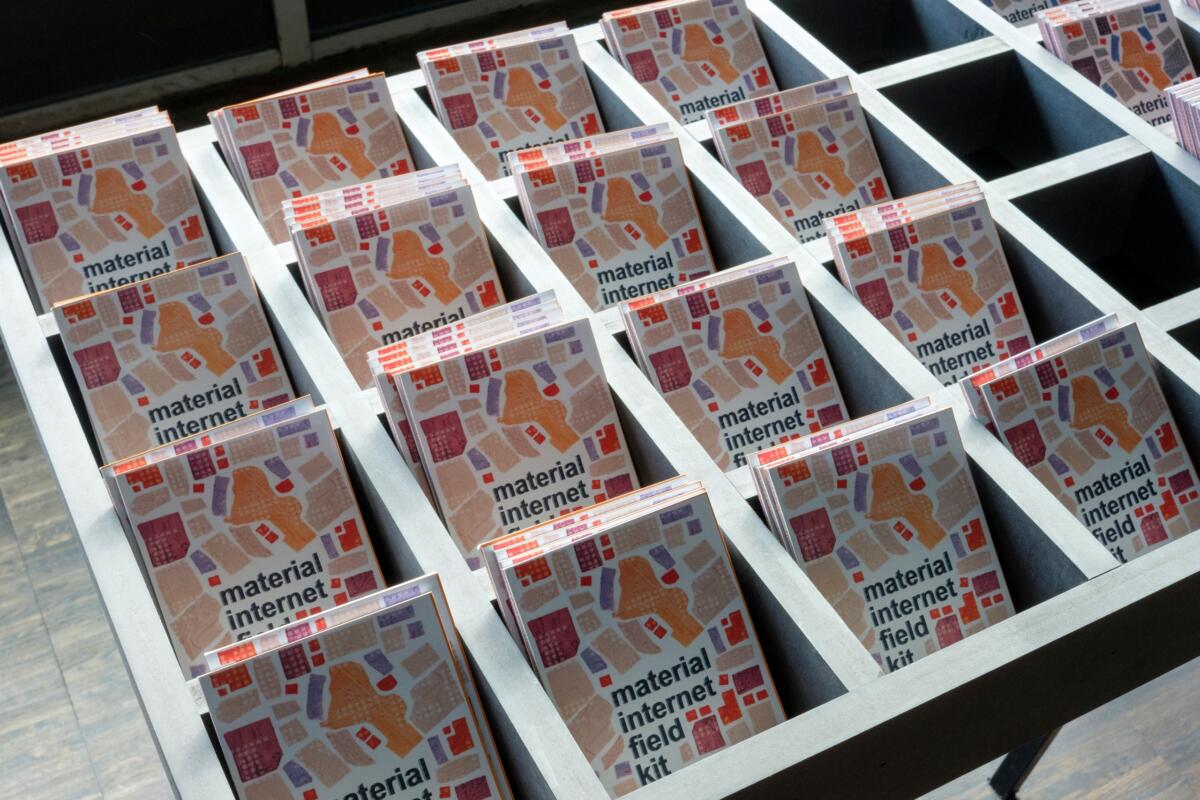
This black hole metaphor relates to the Serbian artist and theorist Vladan Joler. His work is shown in the Extractivism category, which is perhaps surprising at first glance, because the term is primarily associated with the exploitation of the earth’s resources and its biosphere. In current times, it has acquired an additional level of meaning, referring to humans being abused as data pools through the traceability of their internet activities.[6] Standing in front of Joler’s assemblages, it seemed like a lesson in the physics of digital space. His work is inspired by Louise Drulhe’s theory which relates Einstein’s theory of gravity to the topography of the Internet. “So we can think of massive monopolies and conglomerates such as Google and Facebook as enormous black holes that, with their gravity, create a field so intense that it attracts and swallows the content and users.”[7] Additional graphics depict what happens to the victims when arriving at the bottom of the black hole, because then it transforms into Plato’s cave. The cave walls are filled with shadows, which in the digital world are algorithmic projections, regulated, filtered, and censored.
In addition to metaphorical projections of data, we are presented with actual data sets, such as those featured in the work Asunder by Tege Brain, Julian Oliver and Bengt Sjölén, which could be seen in the Algorithms section of the exhibition. The curatorial statement noted how increasingly sophisticated AI systems improve in “recognizing our predilections, behaviors, needs, desires and habits.”[8] Besides, people are subject to our own observational systems, thus the environment inherently becomes yet another object of examination. The three-channel video projection consisted of changing satellite footage and a data field localizing the images connected to information such as population density, average temperature, etc. They appear as objective studies, comparing ecological risks of different regions. In fact, however, the numbers and the recordings are distorted and create fictitious situations. The work reminded me of my statistics seminar, when we were taught that numbers are anything but neutral. First the data collection process must be analyzed to obtain a more precise statement about the results. Apart from mentioning the software used, such as the CESM climate model or the 144 CPU supercomputer, the process of data collection remained a mystery. This problematic point aimed to be stressed by the artists, since these kinds of programs are increasingly being used for ecology management. But how much can we actually trust the information that is given? Within the philosophy of mathematics, intuitionism describes the understanding of mathematics as a human created, mental activity and thus is one way of describing the subjective reality. It denies that mathematical laws exist independently from human conceptualization.[9] In other words: AI captures environmental transformation within a subjective-human understanding of the world, but it always stays an approximation, showing a distinctive perspective but not the truth.
It is often this precise lack of transparency and invisibility of the internet that is worrying. The exhibition platformed these concerns in the category of Infrastructure. “The language with which we describe the newest technologies underlines their lightness, agility, elusiveness and immateriality”[10]. However, some of the works in the exhibition showed exactly the opposite. The artist Vanessa Graf, for example, examines the materiality of the infrastructure of the internet in Poland, trying to make its traces visible. In her publication Material Internet Field Kit: Warsaw (2022), commissioned by the Biennale, she gathered stories, drawings, photographs, and other impressions she found on her excursions across Poland. The collection demonstrates how tangible the internet is, from routers to cables, and data centers, data farms or base transceiver stations. Enormous efforts are being made to install and maintain this network, such as the submarine cables throughout the Baltic Sea, creating a connection that spans from Poland to Denmark and Sweden. Through these elements, the artist draws our attention to the danger of the myth of the immaterial internet, which neglects the use of not only material resources, but also the labor demands and the socio-ecological impacts of this industry.
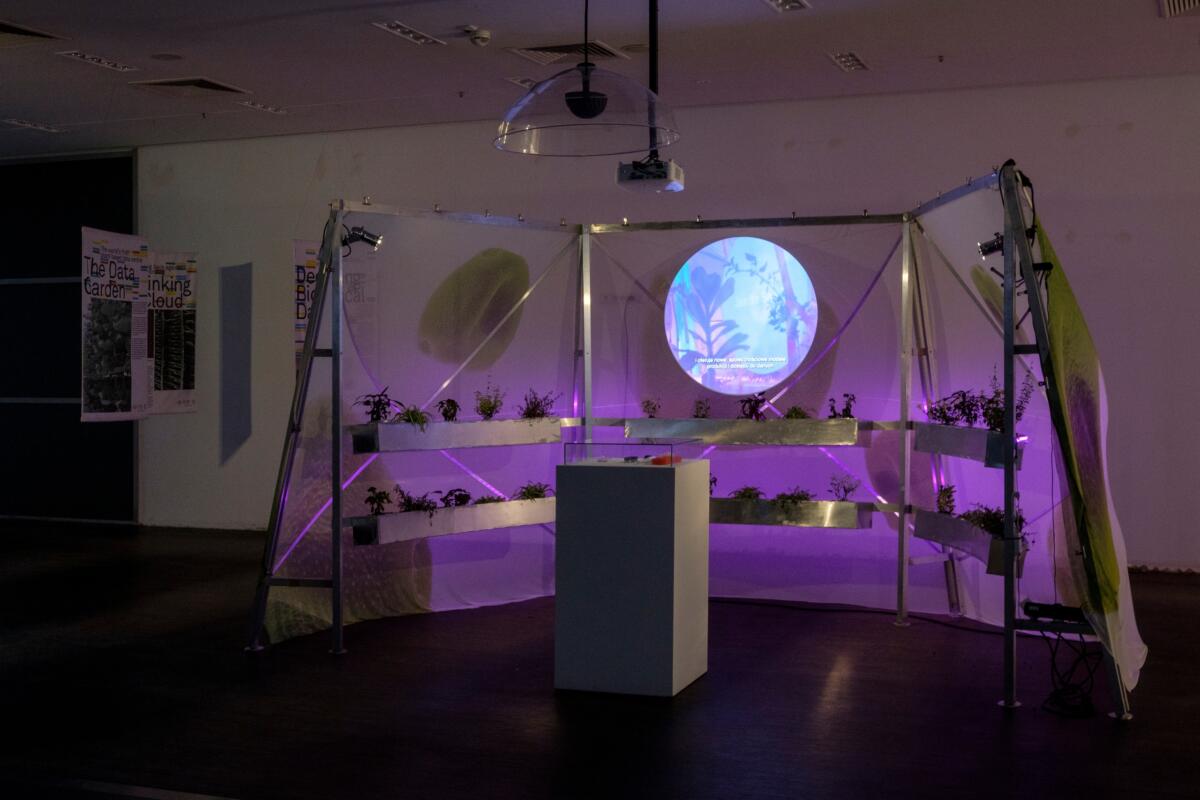



The adjacent work, Data Garden: Grow Your Own Cloud, by the collective Cyrus Clarke and Monika Seyfried, conversely presented a playful approach to this topic. Included in the Future thematic section, the work explores both fictitive and realized possibilities for how existing natural resources can become data carriers. The work seeks solutions concerning ‘data warming’, which describes the greenhouse effect of the data industry. The project started as an artistic intervention in a flower shop, talking to people about their opinions on ‘green’ data storage in the DNA of plants. What sounds like a scenario of a science fiction movie has indeed been an actual research objective for several years at different universities interested in emerging technologies in medicine and biology. Karin Ljubic Fister, a researcher at the University Medical Centre Maribor, Slovenia, was the first to present her findings in 2015 at Falling Walls Lab in Berlin and provoked other research projects to follow on this topic.[11] Grow Your Own Cloud collaborated with the Molecular Information System Lab at the University of Washington to make this possible, that the people in the flower shop could experience what it is like to download their music, images, and other files from plants.[12] While the process is hardly understandable for people not familiar with biotechnology, and therefore difficult to judge about the possible consequences for nature, some rather amateur questions intuitively pop up: What happens to your data, when the plant dies? Or, how ethically justifiable is it to use plants as another tool for the internet? In discussing the decolonization of nature, and the re-thinking of our relationship to so-called non-human entities, this might seem rather a step backwards looking at different regions of the world, where terrestrial elements such as rivers acquire the same legislature as humans, as in the case of New Zealand.[13] Perhaps it might be more helpful to look into the cause of the problem, which is data garbage: Wouldn’t it make more sense to provide data with an expiration date instead of exploring ever larger storage resources?
However, the destruction of the data could lead to political conflicts of interest, which is analyzed in the fifth thematic focus of the Biennale: Surveillance State. With improved technology in the field of data analysis, internet spyware and artificial intelligence, the risk of large-scale unrestricted monitoring of people by their governments increases. This progression of global surveillance supports authoritarian structures and endangers democratic values. A special espionage software is the focus of the research project Digital Violence: How the NSO Group Enables State Terror by Forensic Architecture, since one of their members became a victim of this virus. The project featured TV screens and a projection which showed zoom interviews with the victims of the so-called spy software Pegasus. It revealed the physical and digital threats that opposition politicians, human rights defenders, journalists, and activists are exposed to, if they become a target.[14] One might think that this is a misuse of the World Wide Web, and that it is the exception rather than the rule. However, looking at the history of its creation, this was exactly the internet’s initial purpose, to be used as a military tool. Richard Barbrook describes how MIT was involved in the Vietnam War in the 1970s, using the latest advances in media, tele communications and computing to locate and destroy enemy forces within minutes.[15]
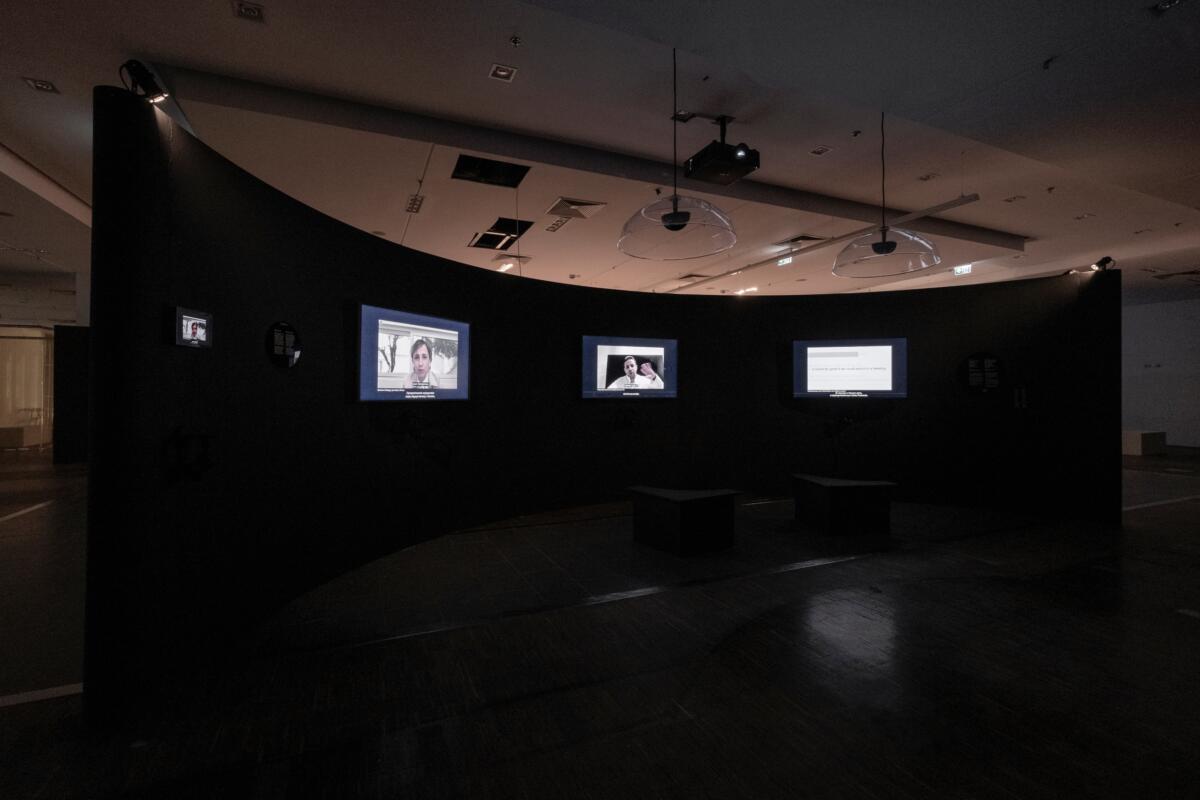
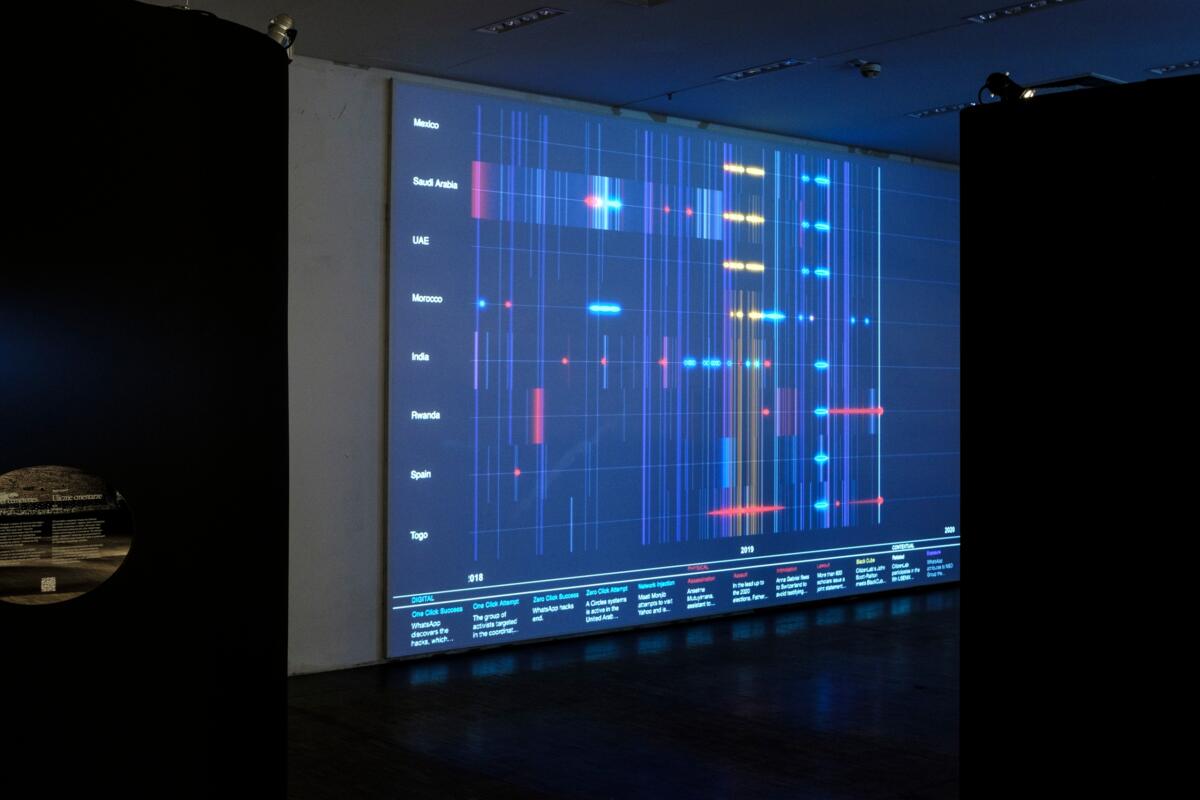

Is the internet a “dark forest” and we only see the trees but not the densely intertwined roots?[16] Is the only way out, to escape mass hysteria, to leave earth and go to other planets? The work The Future Light Cone by Kyriaki Goni is one of the few works in the exhibition that possessed more traditional, craft materiality. The room is hung with tapestries belonging to the Martian Landscapes series, but the content is unusual since it depicted outer space sceneries. Presented in the sixth curatorial theme of Ideology, which at first seemed surprising, upon closer inspection it became clear the artist’s concern is the use of the language applied by Silicon Valley in exploring outer space within colonial narratives. “Could we think of a new anti-colonial language to talk about space exploration? What role could feminism play in that?”[17] From the human perspective, even outer space has become an object of exploitation from which maximum use should be made.
Finding works to help us out of the dark forest, to “imagine a more democratic and egalitarian future,”[18] as the curatorial statement suggests, becomes a bit of a Sisyphean task. Nevertheless, taking the escalator back down down to ground level, there is a moment of relief when re-entering the light-flooded space, busy with visitors and participants exchanging with each other. The curators went to great lengths to create an extensive public program, with artists, media theoreticians, philosophers, new technology researchers presenting their work, giving workshops, and participating in panel discussions. The program was announced with the question “What if the algorithms fed with our data know more about us than we do?”, with contributions from 50 people. Almost every day of the relatively short, month-long Biennial included an on-site event, and due to the special circumstances, the addition of the online lecture series “Armed Democracy”, designed in cooperation with the Kyiv Biennial. This is probably the turning point: in an art world plagued by Zoom meetings and online events, it’s heartening to see that there are so many creative minds tackling the problems of the increasingly digitally connected world. Because precisely through these encouraging off-line initiatives, our coming together and discussing, might be the first step in getting out of this dark forest after all.
Edited by Katie Zazenski
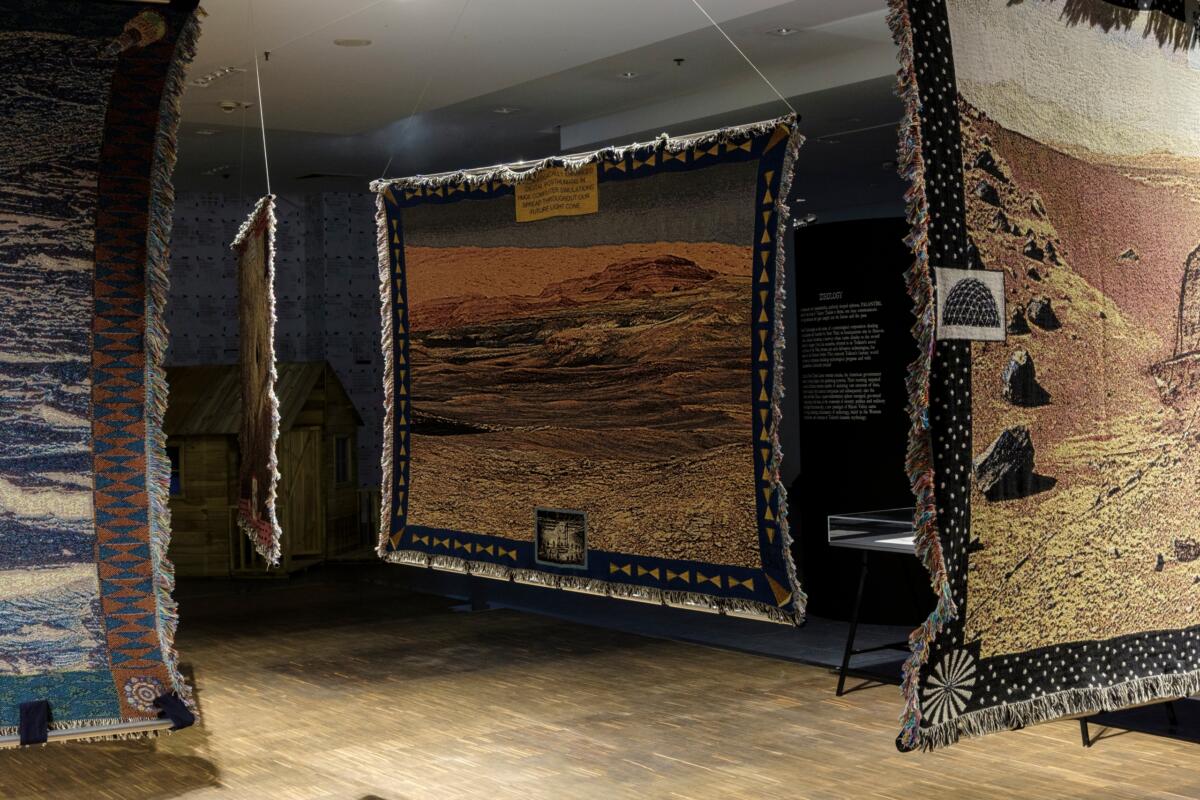
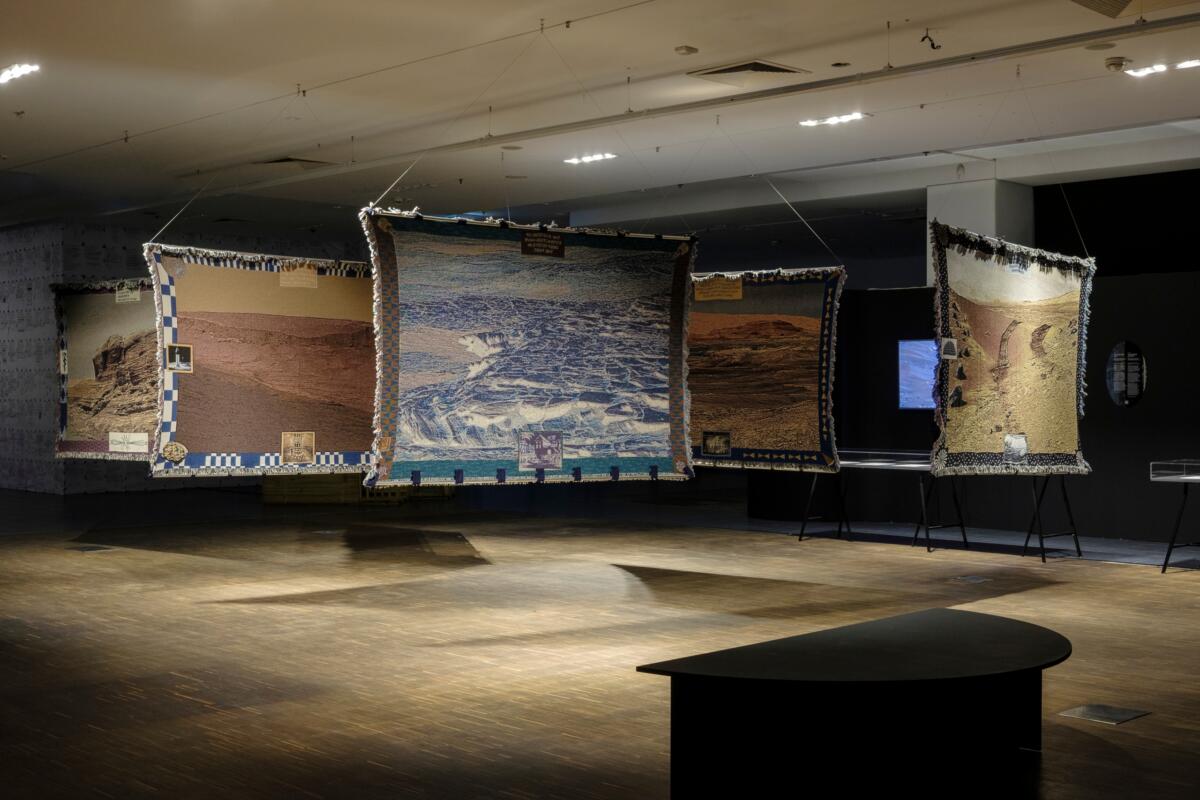
Anna Fech is a curator and researcher. Currently, she is a PhD candidate at Zeppelin University Friedrichshafen (Germany), investigating socially engaged art practices and digital network culture within the post-communist context.
[1] W. Hill: Revealing Revelation: Hans Haacke’s “All Connected”. In: M/C Journal (23/4 2020). https://doi.org/10.5204/mcj.1669 (accessed 10th of August 2022).
[2] Jack Burnham: Systems Esthethics. In Artform 7 (September 1968). https://www.artforum.com/print/196807/systems-esthetics-32466 (accessed 10th of August 2022), p. 31 – 35.
[3] Margaretha J.M. Bijvoet: Art as Inquiry (New York: Peter Lang, 1997), p. 67/68.
[4] Ramesh Srinivasan: Beyond the Valley. How Innovators around the World are Overcoming Inequality and Creating the Technologies of Tomorrow (MIT Press, 2019).
[5] Lecture by Ramesh Srinivasan: Borderless Digital Utopias: Embracing the Interconnections between People, Beings, Past, Present, and our Dreams. 25th of June, as part of the Public Program Biennale Warszawa 2022.
[6] Leaflet with floorplan Biennale Warszawa 2022.
[7] Vladan Joler “New Extractivism”, https://extractivism.online, 2020 (accessed 10th of August 2022).
[8] Leaflet with floorplan Biennale Warszawa 2022.
[9] Douglas Bridges and Erik Palmgren: Constructive Mathematics. in: The Stanford Encyclopedia of Philosophy (Summer 2018 Edition), Edward N. Zalta (ed.), URL=<https://plato.stanford.edu/archives/sum2018/entries/mathematics-constructive/> (accessed 16th of August 2022).
[10] Leaflet with floor plan Biennale Warszawa 2022.
[11] Ryan O’Hare: A living library you can water: Plan to store data in the DNA of plants could see all of the world’s archives secured in a box of SEEDS. In: Dailymail Online. 19.01.2016. https://www.dailymail.co.uk/sciencetech/article-3406604/A-living-library-water-Plan-store-data-DNA-plants-world-s-archives-secured-box-SEEDS.html (accessed 16th of August 2022).
[12] https://growyourown.cloud (accessed 19th of August 2022).^
[13] Camille De Toledo: Le fleuve qui voulait écrire (Les Liens Qui Liberent, 2021).
[14] https://www.digitalviolence.org/#/ (accessed 10th of August 2022).
[15] Richard Barbrook: Imaginary Futures (London Pluto Press 2007), p. 177.
[16] Bogna Konior: The Dark Forest Theory of the Internet (Pittsburgh and New York: Flugschriften, 2020). p. 4.
[17] https://2022.biennalewarszawa.pl/en/stozek-swietlny-przyszlosci-2022/ (accessed 10th of August 2022).
[18] Leaflet with floor plan Biennale Warszawa 2022.
Imprint
| Exhibition | Biennale Warszawa 2022 |
| Dates | 03.06-17.07.2022 |
| Index | Anna Fech Bartosz Górka Bengt Sjölén Biennale Warszawa Data Garden Forensic Architecture Julian Oliver Kyriaki Goni Tege Brain Vanessa Graf Vladan Joler |

